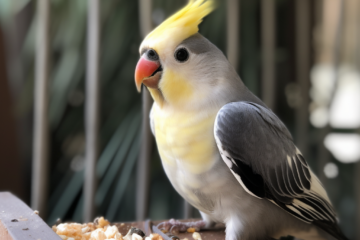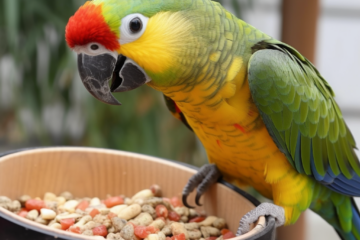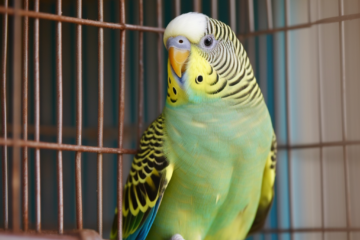Want to create a cozy haven for your feathered friends? Building a birdcage can be both practical and rewarding. While store-bought cages offer convenience, crafting your own wooden frames allows for customization and a personal touch. Dive into the world of DIY birdcages where you get to choose wood materials, square frames, sizes, and designs tailored to your avian companions’ needs. From selecting sturdy wire mesh to adding perches, swings, frames, and square wood, the possibilities are endless when you build a birdcage from scratch. Unleash your creativity while providing a safe and comfortable home for your chirping pals.
Understanding Bird Cage Requirements
Different Species, Different Needs
It’s crucial to understand that different bird species have varying requirements. For instance, small birds like finches need cages with narrow bar spacing to prevent them from escaping. On the other hand, larger parrots require spacious cages with thicker bars for climbing and hanging toys.
It’s essential to research the specific needs of your bird species before starting the construction process. By understanding these requirements, you can ensure that the cage you build provides a safe and comfortable environment for your feathered friend.
Size, Bar Spacing, and Material Matter
The size of the cage is one of the most critical factors to consider when building a bird cage. Birds need ample space to move around freely and exercise their wings. A general rule of thumb is that the cage should be large enough for your bird to fully extend its wings without touching the sides.
Pay attention to the bar spacing of the cage. The gaps between bars should be appropriate for your bird’s size; otherwise, they might get stuck or injured trying to escape. When selecting materials for building the cage, opt for non-toxic options like stainless steel or powder-coated metal to ensure your bird’s safety.
Ventilation and Natural Light Are Key
Adequate ventilation is crucial for maintaining good air quality within bird cages. Proper airflow helps prevent respiratory issues in birds by reducing humidity levels and eliminating stale air. Ensure that there are vents or openings in the cage design that allow fresh air circulation without creating drafts directly on perches or sleeping areas.
In addition to ventilation, natural light plays a significant role in promoting your bird’s well-being. Positioning the cage near a window where it can receive natural sunlight (while avoiding direct exposure) helps regulate their sleep patterns and provides essential Vitamin D production.
Necessary Materials for Building a Bird Cage
Selecting Safe and Non-Toxic Materials
When building a bird cage, it is crucial to choose materials that are safe for your feathered friend. Opt for wire mesh made of stainless steel or powder-coated wire to ensure the well-being of your bird. These materials are non-toxic and durable, providing a secure environment for your pet.
Using toxic materials can harm your bird, affecting its health and well-being negatively. By selecting safe options like stainless steel or powder-coated wire, you prioritize the safety of your bird while ensuring the longevity of the cage. These materials are easy to clean and maintain, making them ideal choices for constructing a bird cage.
Essential Tools and Hardware
To successfully build a bird cage, gather essential tools such as wire cutters, pliers, and a drill. These tools will help you work with wire mesh effectively, allowing you to create a sturdy structure for your bird’s home. Moreover, having suitable hardware like hooks and hinges is vital in assembling the cage securely.
Wire cutters enable you to trim the wire mesh to fit specific dimensions accurately. Pliers come in handy for bending wires and securing connections neatly. A drill simplifies the process of creating holes for attaching various components together seamlessly. Lastly, using hooks and hinges ensures easy access to the cage while maintaining its stability.
Constructing the Bird Cage Frame
Measure and Cut Wire Mesh
To start building a bird cage, measure and cut the wire mesh to fit your desired cage dimensions. Ensure accuracy in cutting to avoid any gaps or misalignments. The wire mesh will form the walls of the cage, providing security for your feathered friends.
When cutting, consider using wire cutters for precision. Make sure that each piece fits snugly together without leaving any openings where birds could escape or get stuck.
Create Frame Structure
Utilize sturdy metal rods or PVC pipes to construct the frame of the bird cage. These materials provide durability and support for the entire structure. Arrange them in a cube shape, with vertical bars connecting at each corner to form a sturdy foundation.
For added stability, reinforce corners and joints by securely fastening them together using appropriate connectors or welding techniques if needed. This reinforcement ensures that your bird cage can withstand movement without compromising its integrity.
Assembling Your DIY Bird Cage
Attaching Wire Mesh
To start building your bird cage, attach the wire mesh to the frame. You can use zip ties or screws for this step. Make sure to secure the mesh tightly around the entire frame to prevent any gaps where your bird might escape.
When attaching the wire mesh, ensure that it is of appropriate size so that your bird cannot squeeze through or get stuck in between. The mesh should be durable and safe for your bird’s well-being.
-
Pros:
-
Provides a secure enclosure for your bird.
-
Allows proper ventilation and visibility.
-
Installing Doors and Latches
After securing the wire mesh, proceed with installing doors on your bird cage. These doors will provide easy access for cleaning and interacting with your feathered friend. Ensure that each door has a sturdy latch to prevent accidental openings.
The latches on the doors should be secure enough to withstand any attempts by your bird to open them from inside. This will help keep your pet safe inside its cage while allowing you convenient access when needed.
-
Cons:
-
Poorly installed latches may result in escapes.
-
Inadequate door size can make cleaning difficult.
-
Adding Accessories Inside
Complete assembling your DIY bird cage by adding essential accessories such as perches, food bowls, and water dispensers inside. Place these items strategically within the cage to create a comfortable environment for your pet.
Provide different types of perches at varying heights to encourage natural behaviors like climbing and perching. Ensure that food bowls are easily accessible but securely attached to prevent spills or tipping over during movement.
-
Securely attach all accessories within reach of each other.
-
Use stainless steel or ceramic bowls for durability and hygiene.
-
Regularly clean and sanitize accessories to maintain a healthy environment for your pet.
How to Make a Large Bird Cage
Adjusting Dimensions
To build a large bird cage, you need to adjust the frame and wire mesh according to the size of your birds. Increasing the dimensions provides more space for them to move around freely, promoting their well-being. By offering ample room, you ensure that your feathered friends can stretch their wings comfortably.
Expanding the cage’s size allows for better airflow and ventilation, crucial for maintaining a healthy environment for your birds. It also prevents overcrowding and reduces stress among them. Consider using sturdy materials like stainless steel or galvanized wire mesh to support the larger structure securely.
Adding Enrichment
Enhance your bird cage by incorporating multiple levels or platforms within it. These additions create an engaging environment for your avian companions, encouraging natural behaviors like climbing and perching. Platforms provide elevated spaces where birds can rest or observe their surroundings from different vantage points.
Offering various levels in the cage promotes exercise and mental stimulation among birds, preventing boredom and encouraging active playtime. You can include ladders, swings, or hanging toys on different levels to further enrich their living space.
Setting Up a Bird Cage for Various Birds
Research Specific Needs
When setting up a bird cage, it’s crucial to research the specific needs of your bird species. Different birds require various types of perches, toys, and feeders. For instance, parrots need sturdy wooden perches to chew on, while finches prefer swings or ladders.
Understanding these requirements will help you create an environment that caters to your bird’s well-being and happiness. By providing the right accessories, you can ensure that your feathered friend stays healthy and entertained in their cage.
-
Research the specific needs of your bird species
-
Provide appropriate perches, toys, and feeders tailored to your bird’s requirements
-
Mimic the natural habitat by offering suitable accessories like bells or mirrors
Create Different Zones
To mimic their natural habitat within a confined space like a bird cage, consider creating different zones. This allows birds to engage in activities they would typically do in the wild. For example, have one area with multiple perches at varying heights for flying birds like budgies.
By dividing the cage into zones such as feeding areas or play spaces with interactive toys or puzzles, you provide mental stimulation for your pet bird throughout the day.
-
Divide the cage into distinct zones mimicking natural habitats
-
Include areas with different perch heights for flying birds
-
Offer interactive toys and puzzles for mental stimulation
Provide Nesting Materials
Breeding birds have unique requirements. It’s essential to offer appropriate materials such as shredded paper strips or coconut fibers so they can build nests comfortably inside their cage.
By providing nesting materials suited to breeding behaviors, you create a conducive environment for reproduction if you plan on breeding your pet birds responsibly.
-
Offer suitable nesting materials like shredded paper strips or coconut fibers
-
Create a comfortable environment for breeding behavior
Optimal Location for Your Bird Cage
Avoiding Direct Sunlight and Drafts
When setting up your bird cage, it is essential to place it away from direct sunlight and drafts. Exposure to direct sunlight can cause overheating, while drafts can lead to health issues for your feathered friend. Find a location in your home that offers a balance of light without the risk of overheating or chilling.
Finding the right spot means ensuring your bird’s comfort and well-being. Consider areas in your home that receive natural light but are shielded from intense sun rays during peak hours. This will help maintain a comfortable temperature within the cage while also providing adequate lighting for your bird’s daily routines.
-
Pros:
-
Ensures optimal temperature control.
-
Prevents health issues related to extreme temperatures.
-
-
Cons:
-
Limited options depending on the layout of your home.
-
Noise Levels and Traffic Zones
Another crucial factor when determining where to place your bird cage is avoiding noisy areas or high-traffic zones in your home. Birds are sensitive creatures, easily stressed by loud noises or constant movement around them. Placing their cage in a quiet area will help create a peaceful environment conducive to their well-being.
Consider locations away from televisions, speakers, or busy hallways where noise levels fluctuate frequently. By selecting a quieter spot, you provide your bird with a sense of security and reduce stress levels significantly.
-
Choose an area with minimal foot traffic.
-
Keep the cage away from loud appliances like TVs.
-
Opt for rooms with lower noise levels such as bedrooms rather than living rooms.
Remember that birds thrive in environments where they feel safe and part of the family routine even if they’re not directly interacting with everyone all the time.
Preparing the Bird Cage Environment
Lining the Cage Bottom
To create a comfortable environment for your feathered friend, line the cage bottom with either newspaper or bird-safe bedding material. This helps in maintaining cleanliness and makes it easier to clean up droppings. The lining should be changed regularly to prevent any build-up of waste that might lead to health issues.
Providing a suitable surface at the bottom of the cage is essential for your bird’s well-being. Birds tend to spend a lot of time on their feet, so ensuring they have a soft and safe area can help prevent foot problems. By using appropriate bedding materials, you are offering them a cozy space where they can rest comfortably.
Offering Toys and Perches
Incorporating various toys and perches inside the cage is crucial for keeping your bird mentally stimulated. Different types of toys such as bells, ropes, or mirrors can provide entertainment and engagement for your pet. Having multiple perches at varying heights allows birds to exercise by flying from one perch to another.
Birds are intelligent creatures that require mental stimulation to prevent boredom and behavioral issues. Providing them with an assortment of toys not only keeps them entertained but also encourages natural behaviors like climbing and chewing. Having different perches mimics their natural habitat where they would perch on branches in the wild.
Regular Cleaning Routine
Maintaining proper hygiene within the bird cage is paramount for your pet’s health. Regularly cleaning all parts of the cage including perches, toys, food/water dishes helps eliminate bacteria buildup that could cause diseases in birds. A consistent cleaning schedule ensures that your feathered companion lives in a healthy environment.
Regular cleaning prevents unwanted odors from developing inside the cage while also reducing potential health risks associated with dirty living conditions. It is essential to establish a routine cleaning schedule based on how quickly waste accumulates in order to keep both your bird and its environment clean and fresh.
Important Warnings for Building a Bird Cage
Avoid Toxic Materials
When building a bird cage, steer clear of using materials like lead-based paint or treated wood. These substances can be harmful to your feathered friend. Opt for non-toxic paints and untreated wood to ensure the safety and well-being of your bird.
Using toxic materials in bird cage construction can have severe consequences, as birds are highly sensitive creatures. For example, lead poisoning from lead-based paint can be fatal to birds. Always prioritize their health by choosing safe and non-toxic building materials.
Mind Sharp Edges and Protruding Wires
Ensure that there are no sharp edges or protruding wires in the bird cage that could potentially injure your pet. Birds are delicate animals with fragile bodies, so any rough surfaces or exposed wires pose a significant risk to their safety.
Sharp edges and protruding wires can cause injuries such as cuts or abrasions on your bird’s skin or feet. To prevent such accidents, thoroughly inspect the cage for any potential hazards before introducing your feathered companion into their new home.
Research Local Regulations
Before embarking on bird cage construction, take the time to research local regulations pertaining to bird ownership and housing requirements. Different areas may have specific rules regarding the size, design, and placement of bird cages within residential properties.
Some regions may have restrictions on keeping certain types of birds or require permits for owning them. By familiarizing yourself with these regulations beforehand, you can ensure that your bird cage meets all legal requirements and provides a safe environment for your avian companion.
Summary
You’ve now got the lowdown on building a bird cage from scratch. Understanding what your feathered friend needs, gathering the right materials, constructing the frame, assembling it all together, and setting it up are the key steps. Remember to consider the type of bird you have and its specific requirements when creating their new home.
Now that you’re equipped with this knowledge, go ahead and start crafting a cozy abode for your avian buddy. Get those creative juices flowing and give your bird a safe and comfortable space to call home. Happy building!
Frequently Asked Questions
How important is it to understand bird cage requirements before building one?
Understanding bird cage requirements is crucial as it ensures the safety and well-being of your feathered friend. Factors like size, material, bar spacing, and ventilation directly impact your bird’s comfort and health.
What are the necessary materials for building a bird cage?
You will need wire mesh or bars, pliers, wire cutters, screws or clips, a door latch mechanism, feeding dishes, perches made from safe wood branches, non-toxic paint if desired for decoration.
Is there an optimal location I should place my DIY bird cage?
Choose a spot away from direct sunlight and drafts. Locate the cage in a social area of your home where your bird can interact with family members but ensure it’s also peaceful enough for restful sleep.
How do I prepare the environment inside the bird cage?
Line the bottom with paper or tray liner for easy cleaning. Provide toys for mental stimulation and exercise. Include food and water dishes that are easily accessible but won’t get soiled quickly.
Are there any important warnings to consider when building a bird cage?
Ensure all materials used are non-toxic to birds. Avoid sharp edges that could harm your pet. Double-check measurements to prevent escapes. Regularly inspect and maintain the cage to address wear-and-tear promptly.


